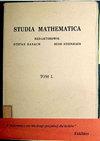若干测度Banach代数中由初等矩阵生成的特殊线性群
IF 0.9
3区 数学
Q2 MATHEMATICS
引用次数: 0
摘要
对于交换酉环$R$和$n\in\mathbb{n}$,设$\textrm{SL}_n(R) $表示$R$上的特殊线性群,$\textrm{E}_n(R) $初等矩阵的子群。设${\mathcal{M}}^+$是$[0,+\infty)$上所有复Borel测度的Banach代数,其范数由总变分、加法和标量乘法的常用运算以及卷积给出{SL}_n(A) =\textrm{E}_n(A) $的Banach子代数$A$,$t\in[0,1]$,其中$\mu_t(E):=\int_E(1-t)^x d\mu(x)$for$t\in[0,1)$,Borel子集$E$of$[0,+\infty)$,$\mu_1:=\mu(\{0\}$\textrm{SL}_n(A) =\textrm{E}_n(A) $neverthess持有,也给出。本文章由计算机程序翻译,如有差异,请以英文原文为准。
Generation of the special linear group by elementary matrices in some measure Banach algebras
For a commutative unital ring $R$, and $n\in \mathbb{N}$, let $\textrm{SL}_n(R)$ denote the special linear group over $R$, and $\textrm{E}_n(R)$ the subgroup of elementary matrices. Let ${\mathcal{M}}^+$ be the Banach algebra of all complex Borel measures on $[0,+\infty)$ with the norm given by the total variation, the usual operations of addition and scalar multiplication, and with convolution. It is shown that $\textrm{SL}_n(A)=\textrm{E}_n(A)$ for Banach subalgebras $A$ of ${\mathcal{M}}^+$ that are closed under the operation ${\mathcal{M}}^+\owns \mu \mapsto \mu_t$, $t\in [0,1]$, where $\mu_t(E):=\int_E (1-t)^x d\mu(x)$ for $t\in [0,1)$, and Borel subsets $E$ of $[0,+\infty)$, and $\mu_1:=\mu(\{0\})\delta$, where $\delta\in {\mathcal{M}}^+$ is the Dirac measure. Many illustrative examples of such Banach algebras $A$ are given. An example of a Banach subalgebra $A\subset {\mathcal{M}}^+$, that does not possess the closure property above, but for which $\textrm{SL}_n(A)=\textrm{E}_n(A)$ neverthess holds, is also given.
求助全文
通过发布文献求助,成功后即可免费获取论文全文。
去求助
来源期刊

Studia Mathematica
数学-数学
CiteScore
1.50
自引率
12.50%
发文量
72
审稿时长
5 months
期刊介绍:
The journal publishes original papers in English, French, German and Russian, mainly in functional analysis, abstract methods of mathematical analysis and probability theory.
 求助内容:
求助内容: 应助结果提醒方式:
应助结果提醒方式:


